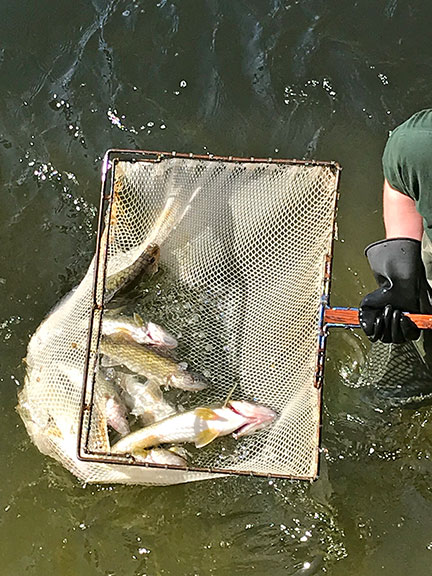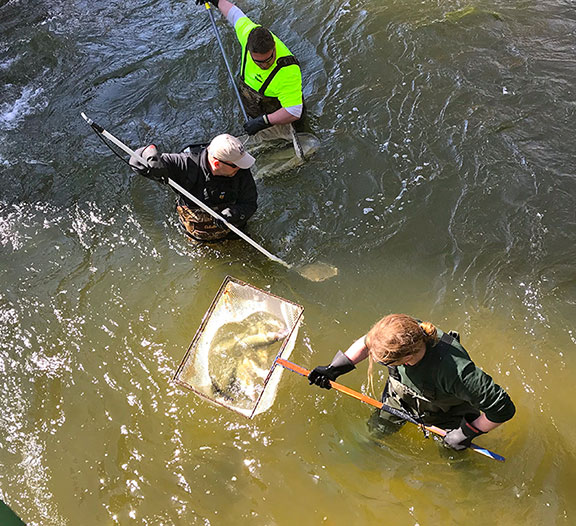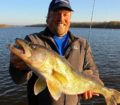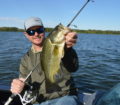By Steve Weisman
 As I entered the Spirit Lake Hatchery last Friday (April 27), I saw DNR biologists and technicians busily collecting walleye eggs from big female walleyes. “How can that be,” I asked myself, “with the lakes still mostly ice covered. Where are they getting these fish?” Gillnetting this year has been limited to only a couple of boats able to find just enough open water to net a few nights. Those efforts had already yielded 640 walleyes as of April 28th. However, another 662 spawner walleyes had been caught during that same time period without gillnets.
As I entered the Spirit Lake Hatchery last Friday (April 27), I saw DNR biologists and technicians busily collecting walleye eggs from big female walleyes. “How can that be,” I asked myself, “with the lakes still mostly ice covered. Where are they getting these fish?” Gillnetting this year has been limited to only a couple of boats able to find just enough open water to net a few nights. Those efforts had already yielded 640 walleyes as of April 28th. However, another 662 spawner walleyes had been caught during that same time period without gillnets.
Where are these fishing coming from if the gillnetting has been limited? As Paul Harvey used to say, “And now for the rest of the story.” Spirit Lake Fishery manager Kim Hawkins and her crew took the other 662 spawners in unorthodox ways.
As Hawkins told me earlier in April, “Walleyes are triggered to spawn by two things. First is the photoperiod or length of day. The optimal date is somewhere around mid-April. Water temperature is also important with most spawning happening when the water temps hit the mid-40s.”
With the warmer water at the north end of East Okoboji, the walleyes were heading to that shallow water, but in addition, they were also drawn into the spillway, which is running high with water from Big Spirit Lake. The DNR found hundreds of walleyes fighting that current in that narrow spillway. Adult walleyes there for the taking! So, the workers put on their waders and proceeded to net 359 walleyes in four days of effort.
The process went like this. One of the biologists would don a special backpack, which is specifically designed to shock fish. The electrical current this unit puts in the water is very mild, but is highly engineered to stun fish and not hurt them. Electricity flows from a battery into the control box on the backpack and then into the water through a long hand wand. A wire trails behind in the water to complete the circuit. As fish are stunned, other biologists on either side quickly dip net the fish in the rapidly flowing water and transfer them out of the spillway and into a tank truck. It is definitely treacherous work in such fast moving water with nets full of big walleyes.
If that weren’t enough, another 303 walleyes were taken during the same four-day period in the fast water at the end of the spillway in East Okoboji Lake. Crews used an electrofishing boat and a team of netters to catch the stunned fish as they drifted downstream.
All of this non-traditional work has been done during the daylight hours, with traditional gillnetting efforts taking place at night and into the early morning. I guess you could say that even during an abnormally late ice out with limited options for netting, Hatchery personnel have followed the old adage “where there is a will, there is a way!” The bottom line is this: we don’t have walleyes if these folks can’t catch enough fish. No matter the means, they continue working long days and nights to get the job done.
This was going to be the end of the story, but then Mike Hawkins, fisheries biologist, gave me a call on Saturday afternoon and said they would be electroshocking the fast water in the narrow spillway late Sunday morning. It was really kind of cool with several dozen spectators watching. As Mike and two other biologists donned their waders, the tank truck was stationed near the bridge and other DNR personnel were standing on the bridge waiting to take the nets with walleyes and put them quickly in the tank.
Watching the three biologists work their way through the rocky bottom and into the fast current, it definitely was a risky and tricky task. It was kind of cool as Hawkins extended the probe to the bottom, walleyes began to pop to the surface with the two netters working to catch the walleyes as they floated downstream. Pretty soon, bystanders were yelling encouragement as if at a ball game. “Hey there’s one over there,” “Look to your left,” “Whoa, there’s a big one, get her!” Pretty incredible stuff!
Largest walleye taken this spring so far is an 11.2 pounder and the largest musky taken is a 37.5 pounder, obviously from East Okoboji. Limited gillnetting and the daytime electrofishing will continue, and as it does the hatchery will continue to fill with eggs.



















